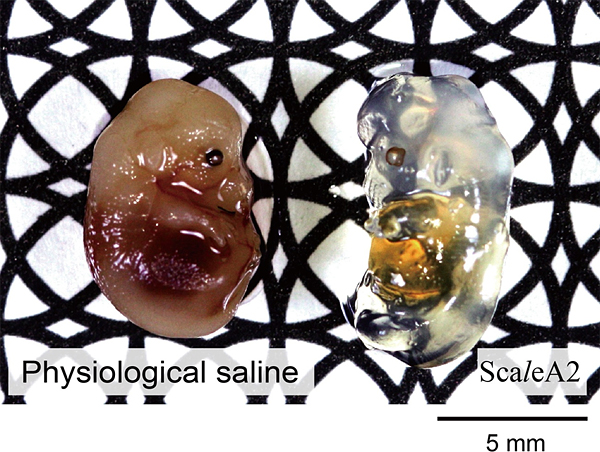Optical clearing with Scale
Posted by Paul O'Neill, on 8 September 2011
Transparency.
A desirable virtue in many walks of life, and a particularly useful trait in developmental biology. Model organisms that are see-through offer unique advantages, especially when it comes to detailed 3D imaging.
A new report in Nature Neuroscience offers a potential advance in this area. Researchers from Japan have stumbled upon a novel aqueous solution that renders tissues transparent with less of the non-desirable side effects of other methods. Their results look impressive: whole mouse embryos are presented which are completely see-through. The new clearing solution has the considerable benefit of not quenching fluorescent proteins – extremely useful for imaging transgenic animals.

The benefits of this reagent are clear (excuse the pun); it’s cheap to make, effective, and produces great imaging conditions. The authors demonstrate some potential applications by performing 3D reconstructions of mouse commissural axons from intact brain samples, and by visualising the intricate relationship between neural stem cells and blood vessels from dissected hippocampus.
One drawback of the procedure (for me at least) is the speed at which the reagent works. The beautifully clear whole mouse embryo highlighted above was treated for 2 weeks. The variant reagent ScaleU2 (optimised to limit swelling of soft tissues) is slower still; the transgenic mouse embryos in figure 6 of the paper were treated for 6 months! In contrast, the organic reagent BABB (benzyl-alcohol/benzyl-benzoate mix) works in a matter of minutes, although it does harden tissues, and also reduces fluorescent signals.
For 3D imaging of traditionally opaque embryos, the new Scale reagent could be a key innovation – you’ll just need a little bit of patience to use it.
Hama, H., Kurokawa, H., Kawano, H., Ando, R., Shimogori, T., Noda, H., Fukami, K., Sakaue-Sawano, A., & Miyawaki, A. (2011). Scale: a chemical approach for fluorescence imaging and reconstruction of transparent mouse brain Nature Neuroscience DOI: 10.1038/nn.2928


 (9 votes)
(9 votes)